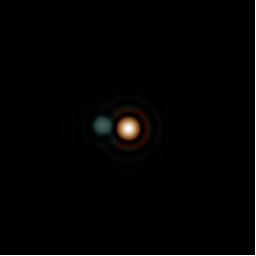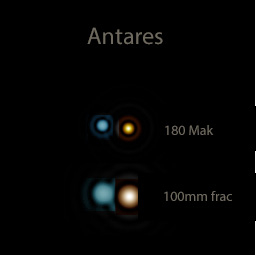-
Posts
2,904 -
Joined
-
Last visited
Content Type
Profiles
Forums
Gallery
Events
Blogs
Posts posted by chiltonstar
-
-
I just caught it - quite a sight as ever! Many thanks for the heads-up.
Monday July 29th at ca.23:00 should be nice - Io plus shadow, and GRS all transiting together, with Jupiter at 13 degrees up (Oxford).
Chris
-
 4
4
-
-
With my ED80 (80/600) the best views are with a 3.7mm eyepiece or 5mm.
Chris
-
With Saturn down at murky near-horizon levels, I found I got a better image a few nights ago taking out the 1.5x Barlow I normally use*, imaging at 30 fps with my AS1224. This is therefore at about f15 (probably more like f20 because of the flip mirror and connections), the actual f ratio of the 180 Mak.
With more aperture, I would have thought you would have a brighter image than I was managing?
Chris
* Barlowed, I could barely manage 15 fps at near max gain.
-
 1
1
-
-
Your clouds haven't reached here yet - the view of Saturn is glorious, with a very sharp view (x240) considering it's so low down, with lots of ring detail!
I too have security light nearby and of course the nearly full Moon is a nuisance, but it hardly matters for Saturn.
Chris
-
I bought one (ZWO) very recently and found it very easy to set up and use for both visual and imaging. The refs above or the online manual from ZWO were excellent - it is much easier to use than I had imagined, and certainly appears to improve images more than just rgb stacking in Autostakkert can do. Enjoy, and hopefully some clear nights before Jupiter and Saturn slide into the dusk....
Chris
-
 1
1
-
-
I think the key word is "video".
What you see through the eyepiece has been processed by a seriously good computer (the brain) so that you see the sharp detail that may only be fleeting in reality. To capture something like what your eye and brain see requires an avi with say 3000 frames and software to pick out the best frames and stack them. Only then do you get something more like what you see in good moments through the eyepiece. Two night ago, I got a half-decent image of Saturn even at 52 degrees north, and yet individual frames looked very similar to your images above. Persevere!
Chris
-
 2
2
-
-
Just now, Stu said:
The Moon does seem to have magical properties; it steadies the seeing and clears clouds away too!! 😜
....we all notice how often clear nights coincide with full moon!
Chris
-
 3
3
-
-
Last night's conditions here produced a clear sky and excellent seeing for an hour even at Jupiter and Saturn's low altitude. The Moon near to Jupiter seemed almost to enhance the seeing.
A transit of Io was just beginning, and the small disk could be seen just beginning to touch Jupiter, and then moving across as a clearly-defined creamy-white disk across the North Equatorial Belt for some distance. Ganymede was clear as a slightly darker clear disk, with minimal flaring around it from the seeing. Both Jupiter's main belts were beautifully defined for 20 minutes or so. I never caught the shadow transit as cloud had descended by then......
Saturn was very well defined, with the view snapping in and out almost like a NASA image for the odd second or two, with a razor sharp Cassini visible all the way round and plenty of band detail on the disk itself.
Scope: 180 Mak, x190 for Jupiter, x270 for Saturn, both with ADC.
Chris
-
 6
6
-
-
Sounds like an excellent session John.
Saturn has to be the most glorious sight in the heavens, even when viewed through all the atmospheric mush this year!
Chris
-
 1
1
-
-
Fantastic scope Stu, and a good one for doubles - what does it weigh?
Chris
-
Pretty good for this near to the North Pole!
Chris
-
 1
1
-
-
1 hour ago, Pete Presland said:
Very nicely captured, I think the ADC is certainty a help downn at the current altitude.
Thanks.
On several of the AVIs, I can just see the "eye" of the GRS starting to appear - first time this season.
Chris
-
 1
1
-
-
5 hours ago, MKHACHFE said:
Awesome mate. That's pretty much exactly what i saw with my XT8 last week from SE UK at around midnight. Low in the sky for sure, but jaw dropping nonetheless .
Cheers
It was pretty good last night for both Jupiter and Saturn, wasn't it. Jupiter was razor sharp for a while around 23:45 after the haze had reduced a bit, with the GRS nicely on show, and Saturn was as sharp as I've seen it this year (x270) with Cassini beautifully defined and banding visible on the disk. Unfortunately, cloud came up here about midnight!
Chris
-
 2
2
-
-
In recent tries, I have found it is easier using an ADC . The separation is quite a bit cleaner, at least with a 180 Mak.
Chris
-
Very interesting Geoff! It is said that there is a lot of eyepiece snobbery about, and maybe it is true.
I don't have a 4mm SLV, but I do have theVixen 15mm SLV which is now my main EP for Jupiter (x190). What I can say (cpd with an SW EP of similar fl and a BST one) is that the contrast is better in the central region of the field of view, the colours more natural and unlike the BST, it doesn't have an annoying reflection which skips around as the eye moves. It does have an area of CA though around the outer field of view.
I wonder though how much of the benefit with an EP like the Vixen SLV is scope-dependant? Clearly fast scopes need better EPs than very slow ones.
Chris
-
 1
1
-
-
-
Nice to get out on these glorious summer evenings! A nice selection Nick.
Chris
-
 2
2
-
-
After three evenings assessing my newly-acquired atmospheric dispersion corrector (ADC - ZWO) visually, I had a 30 minute slot to test it out last night with an AS1224 camera attached to the 180 Mak. This is the best of three, and still not much compared to the experts with skill+location+aperture (skill being the most important factor I suspect) all three of which I lack!!
Transparency was good/excellent, seeing about the same and the elevation above the horizon about 15 degrees.
The ADC has apparently made the image slightly sharper than other recent attempts over the last two weeks I've made at Jupiter (I couldn't test with and without ADC last night because of the very limited time until Jupiter crashed into a tree). Subjectively, I would say the colours were much "cleaner", more like the silvery pearl we see when Jupiter is higher above the horizon, and this has confirmed visual observations in the last few days.
Chris
-
 7
7
-
-
What will the weight of this one be when finished Stu? (I'm thinking of your back, and more significantly mine as I'm wondering about a large truss tube Dob)
Great project!!
Chris
-
11 minutes ago, John said:
Thanks for that Chris. If those position angles are right then that builds my confidence more that I got the split. I'd say that last night the secondary looked a smaller blob than the primary and rather more the colour of dirty blu tack !
It was good to be observing something last night, I've not been out much due to the poor weather lately.
The Stelle Doppie figure for PA is 277 degrees which matches what we both saw I think. The blue of the secondary may be aperture dependent as I would say with 180mm it was definitely blue-green 'ish, although of course with atmospheric refraction and seeing wobbles, colour is always a bit subjective!
On my original, the intensity ratio looks right, but shrinking the file and copying across has made the intensities look more similar. Unfortunately, my laptop was also trying to perform a couple of updates (G knows what) which corrupted the image file slightly. This is the 100mm simulation with the blue-green intensity reduced to something more like the correct ratio (it makes the colour slightly more Blu Tack'ish maybe?):-
Chris
-
 1
1
-
 1
1
-
-
6 hours ago, David Levi said:
Well done John. I feel a bit disappointed now as I've just come in after failing to split Antares with my Takahashi FC-100D. I tried to see the smaller partner star without knowing its location and after giving up and looking up its position I still couldn't see it or even imagine that I could see it. I was binoviewing at approx. 200x magnification. There was a bit of unsteady atmosphere at that magnification and the diffraction rings weren't helping. It was a fun challenge though and one I will return to now that your experience has shown that it is possible with a 100mm apo refractor.
I've done it in the past with an 80ED - I don't think aperture is the main issue really, it's more about seeing and as John says, having a clear S aspect (and of course having any clear nights).
This is a simulation (Aberrator) of Antares with a 180 mm Mak and a 100mm frac - you can see both can split it easily; I've added a bit of colour for fun!
Chris
-
 3
3
-
-
2 hours ago, MarsG76 said:
Seeing that much detail in the eyepiece is some view.... I love those rare moments where I can push Jupiter to 500X mag and it's massive, clear and detailed in my dob.... rare but WOW so I share your excitement.
At UK elevations for the gas giants, normally x150 to x250 seems to be the best range of mag, although I have used much more when they are higher in the sky.
Chris
-
 2
2
-
-
The rain cleared the murk here a little and Jupiter was visible as it should be - a worthy competitor to Venus!
At 11 degrees elevation though, the seeing was far from perfect, with fractions of a second of detail every minute or so, with the GRS nicely visible. Later, when Jupiter is higher, I have a house and some trees inconveniently positioned so it was 11 degrees or nothing! Best seeing I've had for Jupiter so far this year though.
This quick image shows the amount of detail I could (intermittently) see (180 Mak, AS1224). Oh for a more southerly location!
Chris
-
 12
12
-
-
60 degrees ........wow! I split it again two nights ago, and I had to use a much lower mag because of the near horizon seeing - x90 gave the sharpest view of the blueish-green secondary, nearly due West of the primary.
Chris
-
 4
4
-















Zeta Herculis
in Observing - Reports
Posted
Ed's point about focus is a good one - the secondary is on or close to the first diffraction ring of the primary and if the scope is even a tiny bit out of focus, the secondary just becomes a "brightening" of the diffraction ring to me rather than a pinpoint. With my 180 and 127 Maks I split it fairly easily in good conditions, but it takes a bit of a wiggle with the Baader helical focuser to get it dead right.
Chris